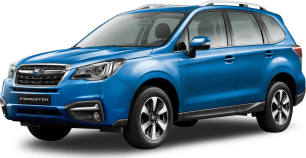The Forester could be the most practical vehicle in its class. Against the likes of the Toyota RAV4, Mitsubishi Outlander, Mazda CX-5 and VW Tiguan, it stacks up pretty well for cabin practicality, space utilisation and accommodation.
It's a nice, bright and airy place to be, with a big glasshouse that makes it feel a bit more outdoorsy than its rivals. The benefits of that are two-fold - it's easy to see out of, whether you're the driver or if you're a kid in the back.
Looking up front first, the Forester's cabin presentation is much more eye-catching in this grade. The other models in the range are, well, a bit bland. The Sport, though, is a bit more - dare I say it - sporty. And I personally hate models called Sport, but that's a story for another day.
The orange stitching everywhere and the orange metallic look finishes on the dash and the centre console - it combines for a more special feeling cabin than any of the other Foresters available.
I really appreciate the media screen Subaru offers - it's easy to use and is bright and colourful, and also the flush finish design - not a floating tablet style screen - does make it just a little easier to use. However there is a secondary screen above it, which shows you a bunch of information about the car that you theoretically will never actually need to know.
That top pod also has a driver monitoring camera system which is looking at you all the time and will warn you if you take your eyes off the road for too long. Intriguingly, it flashes a warning onto another screen - the one on the instruments, which also makes you look away from the road...
It really is a button and screen overload. If you like minimalism, you're not going to like the number of things in front of you as the driver of a Forester. But they all have a purpose (sort of), and for me, it's better than everything being run through touch screens!
The front seats are quite comfortable, with electric adjustment for the driver and passenger. Both are electric adjusted and heated as well, which is nice, and the material used is genuinely really comfortable - it's like a good quality couch.
Even though those are nice elements, I couldn't find myself a perfect driving position – I feel like I sat just a little too high and I couldn't get the steering wheel in quite the right position for my preferences.
Storage is mostly okay up front: the cupholders between the seats are a little bit deep so small takeaway coffees might be hard to get out, and there are bottle holders in the doors, a small cubby in front of the gear selector for a wallet and/or phone, and that's also where you'll find 2USB ports. No wireless phone charging, though.
The overall space for a family of four is perfectly usable. There is no seven seater version of the Forester, nor any seven-set SUV in the brand's range at all in Australia, so it's strictly a smaller family affair, or a good option for grandparents on duty.
There's very good second row seat space, with a high seating position and hip point allowing for adults to easily slot in there (I'm 182cm/6'0" and I can fit behind my driving position with heaps of leg, toe and headroom to spare), but it's also a handy height for child loading, with dual ISOFIX and three top-tether points. Weirdly, though, Subaru has kept with the ceiling-mounted centre seatbelt, and the seat is flat and a bit uncomfortable for adults in terms of cushioning and support. Great for child seats, though.
There are plenty of smart features in the second row, including twin map pockets on the seat backs, one of which is sectioned and divided for smaller items. Plus there are those two USB ports for charging devices (again, perfect for a family of four), and there are rear directional air vents. There is a fold-down armrest with cupholders, plus bottle holders in the doors.
Weirdly there are LED lighting pods for the boot and the tailgate, and up in the front of the cabin there is LED lighting, too - but in the centre, the middle lighting pod is halogen. Weird.
The boot area offers 498 litres of cargo capacity (VDA) with the seats up, but hit the electric release levers (handy!) at the sides of the boot and you liberate a total 1740L of space - enough for a pair of mountain bikes or a few weeks' worth of camping gear for a couple.
Plus there are shopping bag hooks on the outer sides of the boot area and one on the tailgate,, plus four tie down points if you need to attach things and stop it from rolling around. There's a cargo blind, and a 12 V outlet in the boot, too.






